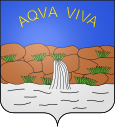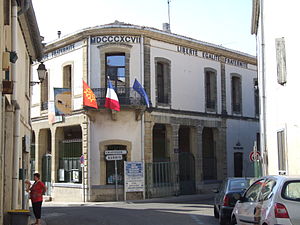Aigues-Vives (Gard)
| Aigues-Vives | ||
|---|---|---|

|
|
|
| region | Occitania | |
| Department | Gard | |
| Arrondissement | Nîmes | |
| Canton | Vauvert | |
| Community association | Rhôny Vistre Vidourle | |
| Coordinates | 43 ° 44 ′ N , 4 ° 11 ′ E | |
| height | 10-87 m | |
| surface | 12 km 2 | |
| Residents | 3,337 (January 1, 2017) | |
| Population density | 278 inhabitants / km 2 | |
| Post Code | 30670 | |
| INSEE code | 30004 | |
| Website | aigues-vives.fr | |
 Mairie Aigues-Vives |
||
Aigues-Vives is a French commune with 3337 inhabitants (as of January 1, 2017) in the Gard department in the Occitanie region .
geography
Aigues-Vives is located between the cities of Nîmes and Montpellier . The A9 runs through the municipality, which is also traversed by the Rhôny . The neighboring municipalities of Aigues-Vives are Congénies and Calvisson in the north, Mus and Codognan in the east, Le Cailar in the southeast, Aimargues in the south, Gallargues-le-Montueux in the southwest and Aubais in the west.
History and culture
The place is located directly on the Roman road Via Domitia , from the side of which a milestone has been preserved. A Roman villa probably existed here in the second century . The remains of another Roman villa from the 4th century are still preserved. The oldest surviving structures date back to the first century, the newest traces that exist date from the time of the Great Migration, when different tribes ruled the region. In 1248 the rulers of Aigues-Vives and Générac , who went to the Holy Land as a crusader , donated the two places to the Knights Templar . This was made by Louis IX. approved.
The village church of Saint-Pierre was destroyed during the Huguenot Wars and rebuilt in 1686 and 1687. In 1803, Napoleon Bonaparte awarded the previously Catholic Church to Protestants, who made up more than 90 percent of the population in the parish. A complaint by the Catholic minority was unsuccessful. The construction of today's Catholic church, which was also named Saint-Pierre , began in 1855. It belongs to the diocese of Nîmes .
The narrow-gauge Chemin de Fer d'Aigues-Vives , commonly known Tramway or Lignette called, was 1892-1901 with three light railway - steam locomotives operated to bring wooden barrels with wine and other fruit industry products from the village, 2 km from the train station.
Population development
| year | 1962 | 1968 | 1975 | 1982 | 1990 | 1999 | 2009 | 2017 |
|---|---|---|---|---|---|---|---|---|
| Residents | 1367 | 1506 | 1611 | 1908 | 2101 | 2329 | 2859 | 3337 |
Personalities
- Émile Jamais (* 1856 in Aigues-Vives; † 1893), French politician
- Gaston Doumergue (* 1863 in Aigues-Vives; † 1937), French President
- Jean Bosc (* 1924 in Nîmes; † 1973), French caricaturist, grew up in Aigues-Vives
literature
- Guy Barruol: Aigues-Vives, Locality of Pataran, canton of Sommières, Gard, France . In: Richard Stillwell et al. a. (Ed.): The Princeton Encyclopedia of Classical Sites. Princeton University Press, Princeton NJ 1976, ISBN 0-691-03542-3 .
Web links
Individual evidence
- ↑ Les commanderies de France et de Belgique , templiers.net
- ^ Website of the municipality
